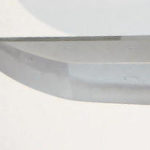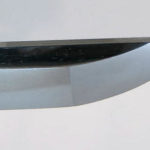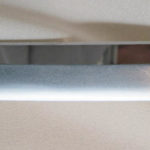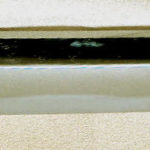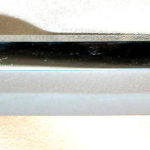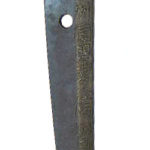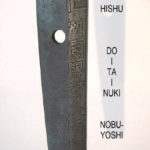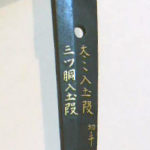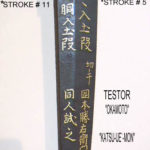Gallery Page (Display Only)
Description
Nobuyoshi with cutting test Circa 1570 AD.
Koto, Higo Dotanuki School
(Very rare school and blade)
NBTHK Tokubetsu Hozon
“NOBUYOSHI” / “MASAKUNI”. SWORD SMITH TO ONE OF HISTORIES MOST FAMOUS SAMURAI!
“TOKUBETSU HOZON”, GOLD INLAYED CUTTING TEST, HIGO ENJU, / DOTANUKI SCHOOL.
“NOBUYOSHI // MASAKUNI”, WAS THE SWORD SMITH TO “KATO KIYOMASA” (ONE OF JAPAN’S MOST FAMOUS GENERALS, C – 1570 AD.)!!! HIS FIRST SIGNATURE WAS “NOBUYOSHI”, UNDER WHICH HIS POPULARITY AND FAME FOR PRODUCING “SUPERB BLADES” FLOURISHED! HE WAS THEN RETAINED BY “KATO KIYOMASA” (SEE BELOW).
AFTER A BRIEF PERIOD, “KATO KIYOMASA” (OUT OF APPRECIATION AND ADMIRATION FOR HIS WORK), GAVE HIM THE PRIVILEGE OF USING THE CHARACTER “MASA”, FROM HIS OWN NAME (THIS WAS ONE OF THE GREATEST HONORS, A DAIMYO COULD BESTOW ON A VASSAL)! “NOBUYOSHI” THEN CHANGED HIS NAME TO “MASAKUNI”! THE MAJORITY OF HIS WORKS ARE ONLY SIGNED “DOTANUKI KOZUKE NO SUKE” (AND IN OTHER WAYS). I WOULD IMAGINE THEREFORE, THAT HIS PERSONALLY SIGNED BLADES, WERE FOR PRESENTATION, OR CUSTOM MADE.
HE IS WELL NOTED IN MANY REFERENCES, AND CLASSIFIED AS A UPPER LEVEL SWORD SMITH, BY DR. HOMMA, AND OTHERS. HIS SIGNED WORKS ARE SELDOM SEEN, AND BLADES WITH HIS “FIRST SIGNATURE” (NOBUYOSHI), ARE VERY SCARCE.
THE HIGO DOTANUKI SCHOOL HAS A DISTINGUISHED ANCESTRY, ITS ROOTS BEGIN IN THE KAMAKURA PERIOD WITH THE FAMOUS “ENJU KUNIMURA” (PLEASE SEE BELOW)!
THE KOTO, HIGO ENJU SCHOOL PROSPERED, FOR NEARLY 300 YEARS. THE EARLY ENJU SCHOOL WAS FAVORED BY DAIMYO’S, AND ARISTOCRAT’S, IT HAS ALWAYS BEEN FAMOUS FOR SHARPNESS, GRACE, MASTERFUL QUALITY, AND DURABILITY.
THE “DOTANUKI” GROUP OF “SUI ENJU” (LATE ENJU), BEGAN IN THE HIGO PROVINCE “VILLAGE OF DOTANUKI”, IN APPROX. 1500 AD. THERE BLADES GAINED RAPID POPULARITY DUE TO THERE SUPERIOR CUTTING ABILITY. THE EARLY DOTANUKI MAKERS HELD “STRENGTH, SHARPNESS, AND DURABILITY IN THE HIGHEST REGARD, AND PAID LITTLE ATTENTION TO ESTHETICALLY PLEASING DETAILS, SUCH AS HORIMONO. THERE MAIN FOCUS WAS ON A BLADE THAT WOULD ENDURE NEARLY ANYTHING, PERSEVERE, AND WIN THE BATTLE FOR ITS MASTER. MANY OF THE DOTANUKI MAKERS FORMED SMALL LOCAL GROUPS. MANY OF THESE DID NOT SIGN WITH PERSONAL NAMES, INSTEAD THEY SIGNED WITH “KYUSHU HIGO DOTANUKI; (NAME OF “HA”)”, SUCH AS: MATAHACHI, HYOBU, JIBYOE, AND SO ON. THIS SHOULD NOT BE MISCONSTRUED AS A DISTINCTION THAT IMPLIES LESSER QUALITY. THESE WORKS ARE (FOR THE MOST PART) MADE TO THE SAME HIGH STANDARDS AS THE FEW (PROBABLY CUSTOM ORDERED) “ARTIST SIGNED WORKS”. I BELIEVE THAT THIS WAS DONE TO ELIMINATE CLIENT FAVORITISM AMONG THE MAKERS. THE TURBULENT TIMES, AND MANY VIOLENT CONFLICTS, RESULTED IN A LARGE NUMBER OF SWORD ORDERS. THIS PRACTICE WOULD HAVE DISTRIBUTED THE “WORK LOAD” MORE EVENLY WITHIN THE SCHOOL. THE SCHOOL ENJOYED GREAT POPULARITY AMONG THE UPPER LEVEL, WARRIOR SAMURAI.
<>
THESE ESSENTIAL ATTRIBUTES, ARE THE REASON THAT “KATO KIYOMASA” ONE OF THE MOST RESPECTED, AND FEARED “SAMURAI GENERAL’S”, SELECTED THE DOTANUKI AS HIS MOST FAVORED “KAJI” ( SWORD MAKERS ). WHEN “TOYOTOMI HIDEYOSHI” SELECTED KIYOMASA TO LEAD HIS INVADING FORCES DURING THE “KOREAN CAMPAIGN”, KIYOMASA TOOK SWORD SMITHS FROM THE DOTANUKI SCHOOL WITH HIM SO TRUSTED BLADES COULD BE PRODUCED, IN KOREA. THIS WAS ONE OF THE HIGHEST VOTES OF CONFIDENCE THAT COULD BE GIVEN TO A SWORD MAKING SCHOOL.
PLEASE SEE THE EXCEPTIONALLY WELL DONE ARTICLE BELOW. FOR AN OVERVIEW OF “THE LIFE OF KATO KIYOMASA” (IT IS COURTESY OF SAMURAI ARCHIVES. COM)
“ENJU FOUNDER”
“ENJU TARO (TITLE) KUNIMURA” FOUNDED THE RENOWNED “HIGO ENJU SCHOOL” OF SWORD MAKING, IN APPROXIMATELY “1305 AD.”, BY THE GREGORIAN CALENDAR ( THE JAPANESE “NENGO” DATING SYSTEM, DOES NOT COUNT THE FIRST YEAR) “700” YEARS AGO! KUNIMURA WAS BORN IN “YAMATO” PROVINCE, AND WAS THE SON OF “HIROMURA”
AN EXCELLENT SWORD MAKER. HE WAS HIS SON’S (KUNIMURA) FIRST TEACHER.
DURING KUNIMURA’S YOUTHFUL YEARS HE MOVED TO THE NEIGHBORING “YAMASHIRO”
PROVINCE, TO BECOME A STUDENT OF “RAI KUNIYUKI”, A SWORD SMITH OF “NATIONAL FAME”! WHILE STUDYING WITH RAI KUNIYUKI ( A NATIONAL TREASURE CLASS MAKER ), HE WAS GRANTED PERMISSION ( I.E.; ASKED BY KUNIYUKI ) TO MARRY RAI KUNIYUKI’S DAUGHTER!!!
KUNIMURA THEN MOVED TO HIGO PROVINCE AND FOUNDED THE “ENJU SCHOOL” WHO’S WORKS GAINED RAPID POPULARITY. KUNIMURA’S WORKS BORE A STRIKING RESEMBLANCE TO THOSE OF HIS SENSEI (TEACHER) RAI KUNIYUKI. THERE ARE ” ONLY 6 ” BLADES BY KUNIMURA THAT ARE KNOWN TO EXISTS TODAY!
Katô Kiyomasa1562 – 1611
Katô Kiyomasa (also known as Toranosuke) was born the son of a blacksmith in Nakamura, a village in Owari that supposedly also produced Toyotomi Hideyoshi. Though often described as a boyhood friend of Hideyoshi, this is unlikely, given the age difference between the men. Nonetheless, he became a retainer of Hideyoshi and distinguished himself at Shizugatake in 1583, where he became known as one of the ‘Seven Spears’ of that battle. He participated in the Invasion of Kyushu in 1587 and fought at the Battle of the Sendaigawa, where he engaged in single combat with the noted Shimazu general Niiro Tadamoto. After the island was secured, Katô received a sizable fief in Higo province worth 250,000 koku. Almost immediately, the fanatically Nichiren Kiyomasa began a persecution of Christians in his domain, which brought him into conflict with his next-door neighbor, the Christian Konishi Yukinaga. It so happened that both men received posts commanding armies in Hideyoshi’s invasion of Korea in 1592. Katô was to drive north on the eastern side of the peninsula after he and Konishi took Seoul and Konishi moved on to Pyongyang. As aggressive as any general in Hideyoshi’s command, Kiyomasa made good time, actually stepping onto Chinese soil briefly at the Tumen River. On the other side of Korea, however, Konishi had run into the Chinese army and fought pitched battles for Pyongyang even as Korean partisans and the Korean navy were wreaking havoc on the Japanese supply lines. In 1594 Hideyoshi began the process of arranging a truce with the Koreans and Chinese and ordered Kiyomasa (much to the latter’s frustration) to withdraw from the north. In June he joined forces with Konishi to capture Chinju, a Castle west of Pusan Hosokawa Tadaoki had failed to take the year before. Soon afterwards, the cease-fire came into effect, one of the provisions of which was that Katô had to release two Korean princes he had captured in the north. In 1597 Hideyoshi ordered that offensive operations commence in Korea, and again Japanese troops marched north, although not nearly with the same rapidity they had in 1592. In the fall of 1597 Katô and Asano Yukinaga found themselves surrounded by a Chinese army at Ulsan Castle, an important post 60 km north of Pusan. Katô and Asano held out in ever-worsening conditions (with their men reduced to the proverbial eating of bark) until for months until a relief operation lifted the siege.
Katô Kiyomasa fighting a tiger in the mountains of Korea
After Hideyoshi died in 1598, both Tokugawa Ieyasu and Ishida Mitsunari courted his support. Ishida’s so – called Western forces might well have gotten themselves a formidable warrior were it not for two factors that decided Kiyomasa, otherwise a Toyotomi loyalist. Firstly – the Western forces were led by Ishida Mitsunari, whom Katô loathed as a civilian interloper and had quarreled with during the Korean campaign; secondly, the Western forces included Konishi Yukinaga. Although Konishi’s navy had aided Kiyomasa quite a bit at the Siege of Ulsan, the two men despised each other as much as ever. Katô joined with Tokugawa and during the Sekigahara campaign (August-October 1600) fought Ishida’s allies on Kyushu and took a number of Konishi’s castles. He was preparing to invade the Shimazu domain when the campaign ended and Ieyasu ordered him to stand down. For his service, Katô was awarded the other half of Higo (formerly owned by Konishi
– executed in the wake of Sekigahara), bringing his income to nearly 500,000 koku.
Kiyomasa passed on in 1611, and it is often speculated that Tokugawa Ieyasu arranged his death. Katô was a friend to Toyotomi Hideyori – Hideyoshi’s son – and this made him a potential stumbling block in Ieyasu’s plan to undermine this last threat to the Tokugawa shogunate. At the same time, a disease-the ‘Chinese pox’, as it was called-was making the rounds, and had already claimed a number of well-known lords (such as Honda Masanobu and Kuroda Kanbei). It is therefore difficult to even speculate on whether the disease provided the cause of Kiyomasa’s death or a cover-story for it. His son, Tadahiro (1597-1653) was later on accused of treason against the Shogun Tokugawa Iemitsu and was banished-a possible clue to the fall of Katô Kiyomasa.
A ferocious fighter and often ruthless, Katô Kiyomasa was a warrior, nothing more, nothing less. He wrote to his followers later in his life that poetry and dancing were shameful pastimes for a samurai, and ordered anyone who found himself engaged in the latter to commit suicide. His cruelty and love of combat (for sport, he hunted tigers with a spear in Korea) earned him the nickname Kishokan, or, ‘Devil General’.
Gallery
This Sword is not available for purchase.
If you wish to purchase a Japanese Sword please view our Nihonto for sale page or contact us directly via email or contact us at 1(608) 315-0083 any time, please include specifics of what you seek, i.e.: Katana, maker, era, price range etc.
Pictures and content may not be copied without the express permission of samuraisword.com ©


